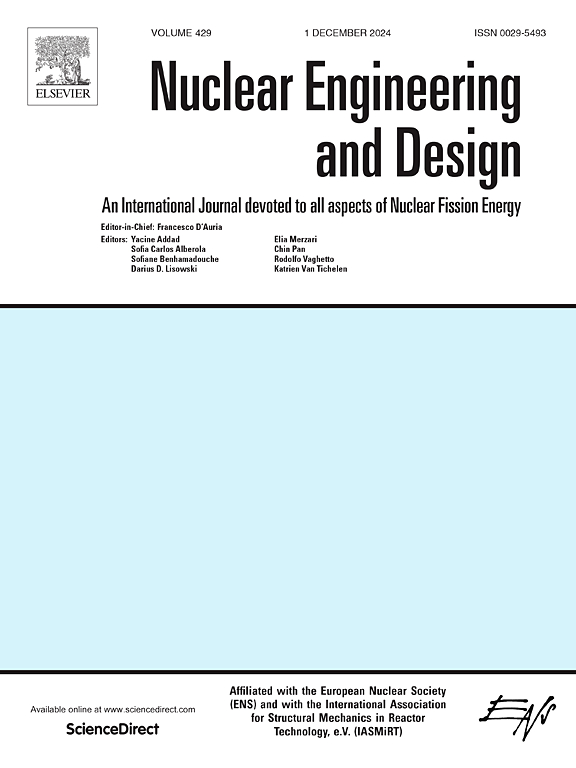Comparison between EDF MAAP5.04 and ASTECv3 codes on hypothetical severe accidents in an integral PWR
IF 2.1
3区 工程技术
Q1 NUCLEAR SCIENCE & TECHNOLOGY
引用次数: 0
Abstract
This paper presents a comparison between EDF MAAP 5.04 and ASTECv3 codes in simulating postulated Severe Accident (SA) scenarios in a generic integral PWR characterized by a submerged containment and about 60 MWe. The code crosswalk was performed by EDF and Tractebel within the Horizon Euratom project SASPAM-SA (Safety Analysis of SMR with PAssive Mitigation strategies – Severe Accident). MAAP is a deterministic code licensed by EPRI whilst ASTEC is an integral code developed by IRSN. Both codes were validated through intense and extensive validation activities and recognized with MELCOR as reference tools for SA deterministic studies in nuclear reactors. In the SASPAM-SA project, code benchmarks were performed between ASTEC, MAAP, MELCOR and AC2. The authors believe that, given the impossibility of conducting SA experiments and the scarcity of available data, such studies are the only way to improve the reliability of these codes. The aim of this work is to investigate capabilities and limitations of SA codes, as well as identify causes leading to relevant deviations in results. This is because the phenomena that occur in SMRs may be different from those that occur in commercial large reactors and may not be captured correctly by models currently implemented. Comparisons performed between EDF MAAP5.04 (SMR code version developed by EPRI and improved by EDF) and ASTEC V3.1 include accident progression from initial events to long-term in-vessel retention of the corium. Particular attention was also paid to the solution adopted to reproduce the strong vessel-containment interaction typical of SMRs. The main differences observed in the results were related to core degradation evolution and corium slumping mechanism in the lower plenum. Discrepancies in core degradation kinetics depend partly on how debris formation is modelled and partly on the different amounts of power exchanged between vessel and containment predicted by the codes.
EDF MAAP5.04和ASTECv3规范在整体式压水堆假想严重事故中的比较
本文介绍了EDF MAAP 5.04和ASTECv3规范在模拟一个60mwe淹没式整体压水堆中假定的严重事故(SA)情景时的比较。该规范由EDF和Tractebel在Horizon Euratom项目SASPAM-SA (SMR被动缓解策略安全分析-严重事故)中执行。MAAP是由EPRI许可的确定性代码,而ASTEC是由IRSN开发的积分代码。这两个代码都经过了密集和广泛的验证活动的验证,并被MELCOR认可为核反应堆中SA确定性研究的参考工具。在SASPAM-SA项目中,在ASTEC、MAAP、MELCOR和AC2之间执行代码基准测试。作者认为,考虑到进行SA实验的不可能性和可用数据的稀缺性,这样的研究是提高这些代码可靠性的唯一途径。这项工作的目的是调查SA代码的能力和局限性,以及确定导致结果中相关偏差的原因。这是因为在小型反应堆中发生的现象可能与在商业大型反应堆中发生的现象不同,并且目前实施的模型可能无法正确捕获。EDF MAAP5.04(由EPRI开发并由EDF改进的SMR代码版本)和ASTEC V3.1之间的比较包括从初始事件到堆芯长期滞留的事故进展。还特别注意了为再现smr典型的强容器-容器相互作用而采用的解决方案。观测结果的主要差异与堆芯降解演化和堆芯下压降机制有关。堆芯降解动力学的差异部分取决于如何模拟碎片的形成,部分取决于代码预测的容器和安全壳之间交换的不同功率量。
本文章由计算机程序翻译,如有差异,请以英文原文为准。
求助全文
约1分钟内获得全文
求助全文
来源期刊

Nuclear Engineering and Design
工程技术-核科学技术
CiteScore
3.40
自引率
11.80%
发文量
377
审稿时长
5 months
期刊介绍:
Nuclear Engineering and Design covers the wide range of disciplines involved in the engineering, design, safety and construction of nuclear fission reactors. The Editors welcome papers both on applied and innovative aspects and developments in nuclear science and technology.
Fundamentals of Reactor Design include:
• Thermal-Hydraulics and Core Physics
• Safety Analysis, Risk Assessment (PSA)
• Structural and Mechanical Engineering
• Materials Science
• Fuel Behavior and Design
• Structural Plant Design
• Engineering of Reactor Components
• Experiments
Aspects beyond fundamentals of Reactor Design covered:
• Accident Mitigation Measures
• Reactor Control Systems
• Licensing Issues
• Safeguard Engineering
• Economy of Plants
• Reprocessing / Waste Disposal
• Applications of Nuclear Energy
• Maintenance
• Decommissioning
Papers on new reactor ideas and developments (Generation IV reactors) such as inherently safe modular HTRs, High Performance LWRs/HWRs and LMFBs/GFR will be considered; Actinide Burners, Accelerator Driven Systems, Energy Amplifiers and other special designs of power and research reactors and their applications are also encouraged.
 求助内容:
求助内容: 应助结果提醒方式:
应助结果提醒方式:


